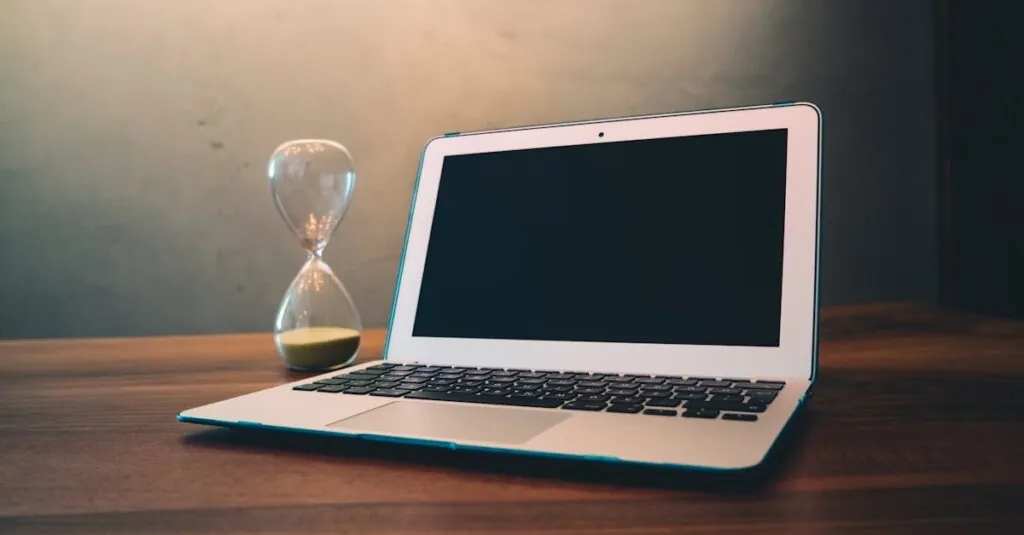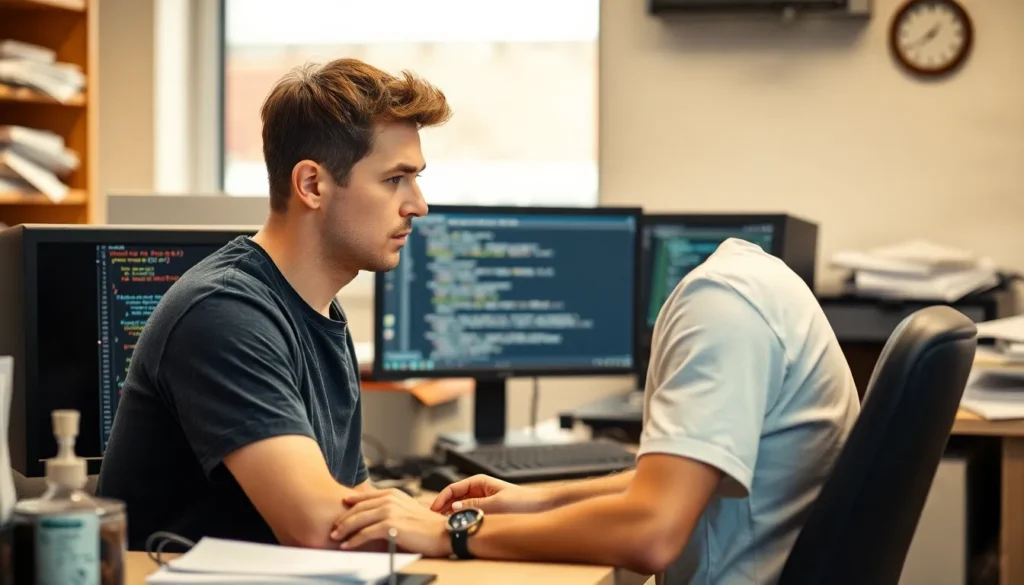Table of Contents
ToggleIn a world where screens dominate daily life, finding a balance can feel like juggling flaming torches while riding a unicycle. Whether it’s scrolling through social media or binge-watching the latest series, screen time has become a double-edged sword. Too much can lead to couch potato syndrome, while too little might leave one feeling like a social hermit.
What Is Screen Time Balance?
Screen time balance refers to an appropriate mix of technology use that enhances well-being. Finding this balance involves assessing the quality and quantity of screen time. Experts emphasize that not all screen time is equal; some activities promote learning and connection, while others may lead to negative health effects.
Healthy screen time includes educational content, virtual social interactions, and productive activities. Establishing a daily limit is important for children and adults alike. The American Academy of Pediatrics suggests tailored guidelines based on age and developmental stage. For instance, children ages 2 to 5 should have no more than one hour of high-quality programming daily.
While screens can foster creativity, excessive use contributes to health issues, including obesity and sleep disturbances. It’s crucial to incorporate offline activities like outdoor play, reading, or family interactions. Setting specific timeframes for screen use promotes mindfulness and reduces mindless scrolling.
Monitoring habits can also aid in achieving a balanced screen time approach. Utilizing apps or built-in smartphone features enables individuals to track usage. Setting family rules around screen time fosters collective responsibility, ensuring everyone engages in healthy behaviors.
Screen time balance involves purposeful use of technology while prioritizing well-being. He or she should engage in regular assessments and adjustments to optimize their digital experiences. With thoughtful marketing of technology, achieving balance becomes a more manageable prospect.
Importance of Screen Time Balance
Screen time balance plays a significant role in overall well-being. Finding equilibrium between digital and offline activities can enhance mental and physical health.
Impact on Mental Health
Excessive screen time negatively influences mental health. Studies indicate that individuals spending over three hours daily engaging with screens experience increased anxiety and depression levels. Such prolonged exposure to social media correlates with feelings of loneliness and inadequacy. Settings that prioritize quality interactions—such as video calls with friends or family members—often foster stronger connections. Mindful screen use, including educational or creative content, can improve cognitive function and emotional resilience. By consciously managing screen time, people can reduce adverse mental health effects while enjoying positive experiences online.
Impact on Physical Health
Screen time significantly affects physical health, particularly among sedentary individuals. Research shows that children engaging in more than two hours of screen time daily face higher obesity rates. Reducing excessive screen use encourages outdoor activities, which promote physical fitness and overall well-being. Sitting for extended periods can lead to posture issues and musculoskeletal problems. Introducing short breaks during screen sessions allows the body to recover and encourages movement. Prioritizing physical activities alongside screen use helps maintain a healthier lifestyle, reducing the risk of chronic illnesses related to inactivity.
Strategies for Achieving Screen Time Balance
Achieving screen time balance requires practical strategies to ensure technology enhances well-being without overwhelming other aspects of life.
Setting Daily Limits
Setting daily limits promotes healthier screen habits. Establishing specific timeframes for screen use helps individuals become more aware of their consumption patterns. The American Academy of Pediatrics recommends tailored guidelines based on age, emphasizing that children aged 2 to 5 should have no more than one hour of high-quality programming each day. Monitoring screens for older children can include both educational and recreational content within a balanced framework. Engaging in regular assessments of screen time can prompt necessary adjustments, ensuring limits remain effective. Technology tools, like screen time management apps, facilitate tracking and support adherence to self-imposed boundaries.
Encouraging Alternative Activities
Encouraging alternative activities presents diverse opportunities for engagement beyond screens. Outdoor play stimulates physical activity and promotes social interaction. Families can organize game nights or creative projects to foster connection without digital distractions. Books, puzzles, and crafts offer enriching experiences that stimulate learning and creativity while reducing reliance on screens. Encouraging hobbies such as sports, music, or gardening allows individuals to discover and develop new interests. Balancing screen time with these activities fosters overall well-being, nurturing both mental and physical health through varied experiences.
Tools for Monitoring Screen Time
Monitoring screen time can lead to healthier technology habits. Various tools exist that assist individuals in achieving better screen time balance.
Apps and Software
Numerous apps provide screen time tracking capabilities. Popular options include “Screen Time,” “Moment,” and “RescueTime.” These applications allow users to monitor daily usage across various platforms, offering insights into consumption patterns. Gamification features encourage reduced usage by rewarding users for reaching set limits. Integration with smartphone settings allows for effortless monitoring and adjustment of screen time. Educational apps can complement screen use by promoting learning experiences that enhance digital literacy.
Built-in Device Features
Devices come equipped with built-in features to help manage screen time. Most smartphones and tablets offer settings for tracking daily usage. Users can access reports that detail time spent on specific applications. Customizable alerts notify users when they’ve approached preset limits. Additionally, features such as “Do Not Disturb” foster uninterrupted offline periods. These built-in tools promote awareness and mindfulness in screen use while supporting healthier habits.
Finding the right screen time balance is crucial for enhancing overall well-being. By prioritizing quality interactions and mindful usage, individuals can enjoy the benefits of technology while minimizing its drawbacks. Incorporating offline activities and setting clear boundaries fosters healthier habits and encourages engagement beyond screens.
Utilizing monitoring tools can provide valuable insights into usage patterns, making it easier to adjust habits as needed. Ultimately, achieving a balanced approach to screen time not only promotes physical health but also supports emotional resilience and social connections. Embracing this balance can lead to a more fulfilling and healthier lifestyle in today’s digital age.




